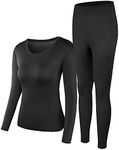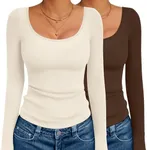Buying Guide for the Best Thermals For Women
When it comes to picking the right thermals for women, it's important to consider a few key factors to ensure you stay warm and comfortable in cold weather. Thermals are designed to provide insulation and retain body heat, making them essential for layering during winter or in cold environments. Here are some key specifications to consider when choosing the best thermals for your needs.MaterialThe material of thermals is crucial because it determines how well they can retain heat and wick moisture away from your skin. Common materials include wool, synthetic fibers, and cotton blends. Wool, especially merino wool, is excellent for warmth and moisture-wicking but can be more expensive. Synthetic fibers like polyester are good for moisture management and are often more affordable. Cotton blends are comfortable but may not wick moisture as effectively. Choose wool for maximum warmth, synthetics for active use, and cotton blends for everyday comfort.
WeightThermal weight refers to the thickness and warmth of the fabric. Lightweight thermals are suitable for mild cold or as a base layer for active use, as they provide some warmth without causing overheating. Midweight thermals offer a balance of warmth and breathability, making them versatile for various cold conditions. Heavyweight thermals provide maximum insulation and are ideal for extremely cold weather or low-activity situations. Consider your typical activity level and the climate you'll be in to choose the appropriate weight.
FitThe fit of thermals is important for both comfort and functionality. A snug fit ensures that the thermals can effectively trap body heat and wick moisture away from your skin. However, they should not be too tight, as this can restrict movement and cause discomfort. Look for thermals that offer a close fit without being constrictive. If you plan to layer them under other clothing, make sure they are slim enough to fit comfortably under your outer layers.
Moisture-WickingMoisture-wicking properties are essential for keeping you dry and comfortable, especially if you are active or prone to sweating. Thermals with good moisture-wicking capabilities will pull sweat away from your skin and allow it to evaporate, preventing you from feeling damp and cold. Look for materials like merino wool or synthetic fibers that are known for their moisture-wicking abilities. This feature is particularly important for outdoor activities or sports.
Odor ResistanceOdor resistance is a valuable feature in thermals, especially if you plan to wear them for extended periods or during physical activities. Some materials, like merino wool, naturally resist odors due to their antimicrobial properties. Synthetic fibers may also be treated with antimicrobial agents to prevent odor buildup. If you are concerned about staying fresh and odor-free, opt for thermals with built-in odor resistance.
Seam ConstructionThe construction of seams in thermals can affect both comfort and durability. Flatlock seams are designed to lie flat against the skin, reducing the risk of chafing and irritation. This type of seam construction is particularly beneficial if you plan to wear your thermals for extended periods or during physical activities. Check for flatlock seams or other comfort-focused seam designs to ensure a smooth and irritation-free experience.






















